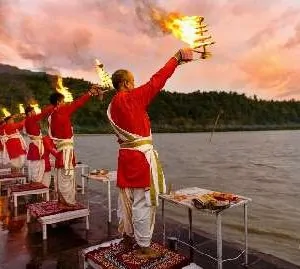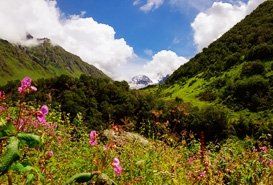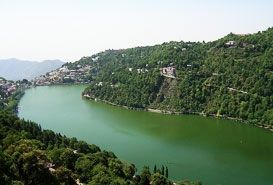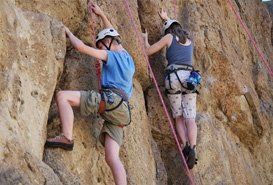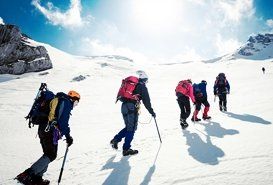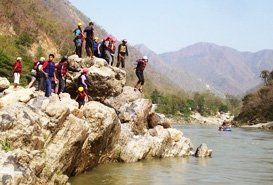Nestled in Uttarakhand, Badrinath is a scenic town. The place is home to Badrinath Temple and is highly revered by Hindu devotees. Thus, the best time to visit Badrinath temple is from May – June, and September – October. This year, 6th May 2025 and 6th November 2025 (tentative) mark the Badrinath temple opening and closing dates 2025. So you can plan your trip accordingly.
| Summers | April to June | 7°c – 18°c |
| Monsoon | July to Sep | 5°c – 15°c |
| Winter | Oct to March | -1°c – 14°c |
When & Where to Visit in Badrinath
Badrinath in Summer – From April till June
Summer is the best time to visit Badrinath. Months between May and June mark the summer in Badrinath. The temperature during these months stays between 7°C to 18°C. Climate is moderately cool and pleasant. Thus, this is the perfect time to have darshan at the Badrinath Dham.
Temperature in Summer
- In March, the Badrinath experiences an average temperature from 3°C to 11°C. The weather remains cold and the region receives occasional snow showers.
- The average temperature of Badrinath in April ranges from 6°C to 16°C. The days remain sunny and balmy. Badrinath Temple usually reopens in late April for pilgrims.
- In May, the average temperature in Badrinath ranges from 11°C to 22°C. Therefore, this is the best time to visit Badrinath Yatra as the pleasant weather makes the holy sojourn comfortable.
- The average temperature in Badrinath in June ranges between 9°C and 14°C. The region experiences sunny and comfortable weather during the daytime, the perfect time to visit Badrinath Yatra.
Browse through our Nainital Tour Package from Kolkata, Uttarakhand Tour Packages from Ahmedabad, Chardham Yatra Packages from Pune
Badrinath in Monsoon – From July till September
Regular rain showers occur in the monsoon months here, starting in July and ending in September. The holy Badrinath Yatra, which takes you to one of the sacred Char Dhams, is not recommended during the monsoon. The occurrence of landslides might create a hindrance in your pilgrimage. The temperature during this time hovers around 5–15°C. Rainfall starts to recede in September. Thus, the influx of tourists once again started rising this month.
Temperature in Monsoon
- In Badrinath, the monsoon starts in July, and the region receives average rainfall. The temperature ranges between 11°C and 14°C. The landslides may hinder the Yatra so it is advisable to keep buffer days.
- In August, the average temperature of Badrinath ranges between 12°C and 16°C. During the daytime, the region remains humid. Therefore, it is highly recommendable to carry a raincoat and umbrella.
- The average temperature in September in Badrinath ranges between 11°C and 14°C. The weather remains balmy and comfortable this month and it is an ideal time for Badrinath Yatra.
Badrinath in Winter – From October till March
Again, October is sometimes considered suitable to visit Badrinath. However, in later months, the temperature falls to -1°C, and the highest it reaches is 14°C. Also, in the winter months, Badrinath gets carpeted with snow. Thus, this is also not a recommended time for planning a Badrinath trip.
Tempertarue in Winter
- The temperature ranges from 12°C to 17°C in Badrinath in October. This month, the region experiences cold weather and occasional snow showers. Therefore, it is advisable to carry woolen.
- In November, the average temperature ranges between 6°C and 14°C. The region starts receiving heavy snowfall, and Badrinath Temple usually gets closed this month.
- The temperature varies between 5°C and 12°C in Badrinath in December. This is because the region receives heavy snowfall, due to which the routes get blocked.
- In January, the average temperature in Badrinath ranges from 1°C to 8°C. Unfortunately, the region receives heavy snowfall this month, and the temple remains closed.
- The climate of Badrinath in February remains cold. The average temperature of Badrinath in February is between 6°C and 10°C. In addition, the region receives snow showers.
- In March, Badrinath experiences an average temperature from 3°C to 11°C. However, the weather remains cold, and the region receives occasional snow showers.
To know more detailed information on Badrinath's temperature as well as weather conditions, click here!
Why visit Badrinath Temple?
Badrinath is among the Chota Char Dhams of Uttarakhand, including Gangotri, Yamunotri, and Kedarnath. It is also among India's Char Dham pilgrimage sites, including Dwarka, Puri, and Rameshwaram. The temple is also known as Badrinarayan Temple and is dedicated to Lord Vishnu.
Situated at an altitude of 3,133 m above sea level, Badrinath Dham is settled amidst the Nar and Narayan peaks in the Chamoli district of Uttarakhand. This is one of the most revered pilgrimage sites with the breathtaking backdrop of the mighty Neelkanth peak. The myriad legends add to the glory of the temple. The temple remains open for six months and closed for the remaining part of the year.
The region experiences balmy and pleasant weather in the summer season, which is the best time to visit for Badrinath Yatra. In monsoon, the region receives heavy rain, due to which the chances of frequent landslides increases. Therefore, it is not advisable to travel during the monsoon season. However, if you plan a tour to Badrinath in monsoon, keep buffer days. Badrinath experiences snowfall in the winter season. In September and October, the region enjoys pleasant weather and moderate cold, making these months the best time to visit for Badrinath Yatra. However, the temple closes in November due to heavy snowfall.
Things to know before you visit Badrinath
- Badrinath Temple opens from late April or early May to late October or mid-November. The rest of the year, the temple remains closed due to heavy snowfall.
- The ideal time to visit the temple is from May to June and September to October.
- It is highly recommendable to avoid late winters and monsoon seasons. The region receives heavy snowfall in the winter season and heavy downpour in the monsoon that causes landslides and floods.Keep buffer days if you plan a trip in the monsoon season.
- Carry heavy woolens, including caps, socks, thermals, and gloves in the winter season. Also, carry sunscreen and sunglasses to avoid sunburn.
- Carry light woolens if you plan for Badrinath Yatra in the summer season.
- In the monsoon, do not forget to carry an umbrella and raincoat.
- Always carry a medical kit with necessary medications for fever, cough, and altitude sickness. Also, carry painkillers and antiseptic creams.
- Wear comfortable clothes and sturdy shoes while traveling.
- Carry a battery-operated torch, fully-charged power banks, and extra batteries for cameras.
- Cover the batteries with warm clothes in winter. The battery gets dead in harsh winters. Only BSNL sim operates here. Make sure you carry one.
- Book accommodation prior as during the peak season, the chances of getting good accommodation at a favorable price decreases.
- Carry important documents, including tickets, cash, and photo identity proof. Pack them in a waterproof bag in the monsoon and winter seasons.
Check out Uttarakhand Tour Packages, Ranikhet Tour Packages, Jim Corbett Packages, Gangotri Tour Packages, Rudraprayag Tour Packages, Chardham Yatra Packages, Rishikesh Tour Packages, Nainital Tour Packages, Lansdowne Tour Packages, Uttarkashi Tour Packages
Badrinath Tour Packages
Cities of Uttarakhand
- Bageshwar
- Barkot
- Bhimtal
- Chamba
- Chamoli
- Champawat
- Doonagiri
- Gaurikund
- Gopeshwar
- Guptakashi
- Haldwani
- Hanuman Chatti
- Har ki Doon
- Joshimath
- Karanprayag
- Khirsu
- Kotdwara
- Nandaprayag
- Naukuchiatal
- Pauri
- Pithoagarh
- Rudraprayag
- Rudrapur
- Sattal
- Tehri
- Uttarkashi
- Yamkeshwar
- Corbett
- Chopta
- Devprayag
- Gangotri
- Hemkund
- Mukteshwar
- Ranikhet
- Valley of Flower
- Yamunotri
- Dhanaulti
- Almora
- Kedarnath
- Lansdowne
- Kausani
- Dehradun
- Haridwar
- Auli
- Nainital
- Mussoorie
- Rishikesh
Things To Do in Uttarakhand
Why Book With Us
35+
Years of Travel Experience
100+
Travel Experts To Assist You
03+
Million Satisfied Guests
Ministry
of Tourism Accredited
- 5/5 Rating:
- 4/5 Rating:






